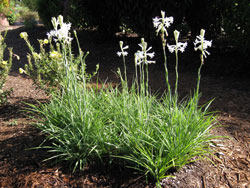Resource Library
Plant of the Week: Tuberose
The University of Arkansas System Division of Agriculture does not promote, support or recommend plants featured in "Plant of the Week." Please consult your local Extension office for plants suitable for your region.
Plant of the Week
Tuberose
Latin: Polianthes tuberosa

Cut flowers, usually gaily-colored mixtures of summer annuals, have been an important part of the modern day renaissance of the farmer’s market. But if one pokes around a bit it is easy to find an old favorite of the cut flower trade, the tuberose, Polianthes tuberosa.
Tuberose is an herbaceous bulbous plant of the century plant family. It produces a series tightly packed slender tuberous stems that give rise to a whorl of 18-inch long basal leaves and a 3-foot tall flowering stem that contains from 8 to 10 smaller stem leaves that clasp the stem. The leaves are bright green and slightly fleshy.
The stems shoot up in the heat of summer and produce a terminal cluster of fragrant, white tubular flowers that are to 2 inches long and three-quarters of an inch across as the petals unfurl. The blossoms are glistening white and somewhat fleshy so they hold up well as a cut flower. Single-flowered forms have six petals but double flowered selections are commonly grown.
The tuberose of the cut flower trade was cultivated in Mexico by the Aztecs. In fact, it has been in cultivation so long it, like corn, does not occur in the wild state. It is what botanists call a "cultigen" - a plant that does not occur naturally in the wild.
The tuberose was introduced to Europe by the Spanish conquistadors during the 16th century. From there it quickly moved around the world where it became a favorite in warm climes such as India, Africa and throughout the Mediterranean region. Because it is summer blooming and grows easily in hot areas it filled a much-needed void for summertime cut flowers. That it was fragrant and long lasting also helped make it an early hit.
The correct common name for this plant is actually "tuber - ose," not the more commonly heard "tube rose." The "tuber-ose" name refers to the technical description of the root system and was used by bulb growers to distinguish it from hyacinths that had similarly shaped and fragrant flowers but grew from a true bulb.
Tuberoses were popular as a florist cut flower during the Victorian era but eventually began to lose favor because they were so heavily used in floral funerary arrangements. The calla lily, carnations and gladiolus have suffered similar losses in favor as they became overly associated with death.
Tuberoses are hardy throughout Arkansas but in northern parts of the state the bulbs should be mulched with 3- to 4-inches of loose mulch during the winter months. They are best when planted in a productive, well-drained garden soil in a sunny situation. For most effective display plant the tuberous bulbs 8 inches apart and 2 inches deep.
Every 4 or 5 years tuberose clumps should be lifted in September for division. Place the clumps in an area protected from rain and allow the root stock to thoroughly dry before cold weather arrives. Over winter, store the clumps in an area protected from freezing with an average temperature around 50 degrees. In the spring divide the clumps and reset the largest divisions. Without lifting and dividing the clumps will contain too many small bulbs and flowering will be greatly diminished. In colder areas north of zone 7 tuberoses must be lifted each fall and stored over winter.
By: Gerald Klingaman, retired
Extension Horticulturist - Ornamentals
Extension News - August 21, 2009
The University of Arkansas System Division of Agriculture does not maintain lists of retail outlets where these plants can be purchased. Please check your local nursery or other retail outlets to ask about the availability of these plants for your growing area.